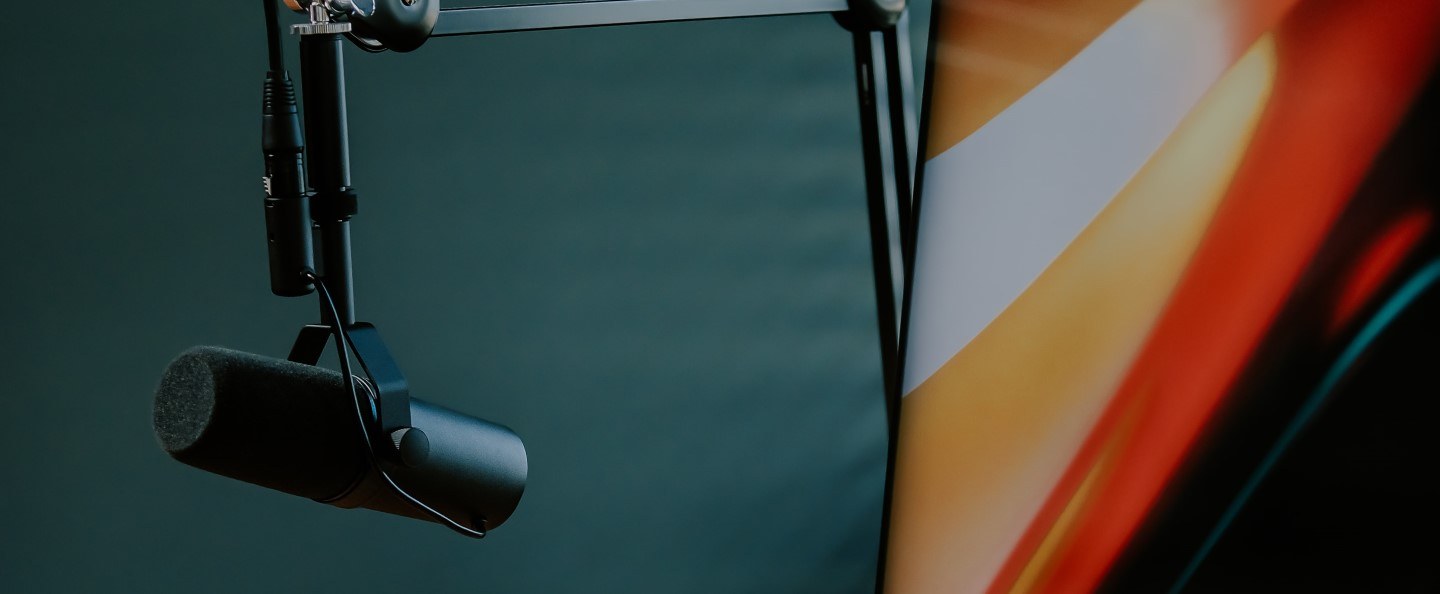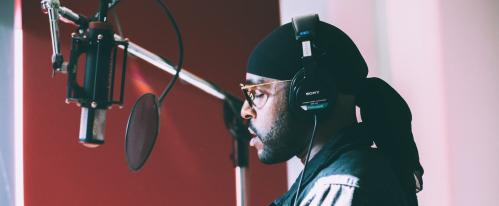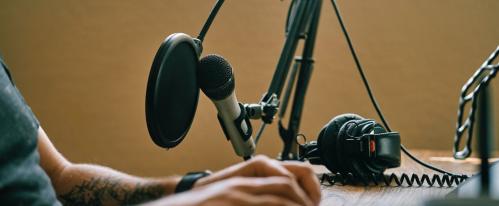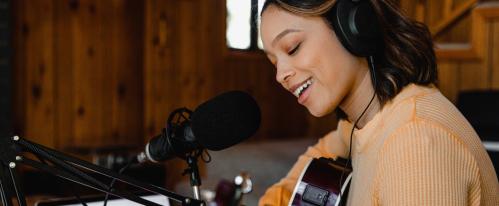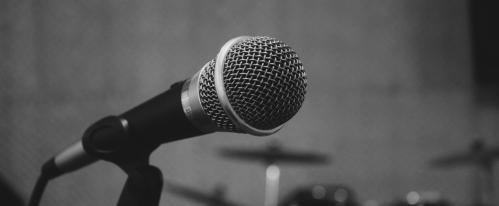We answer the questions: why is the Shure SM7B so popular, why is the SM7B considered the best microphone for vocals and is it worth the price tag?
If you’ve ever wondered to yourself: “why is the Shure SM7B so popular?” you’re not alone. This ubiquitous, widely-used and highly-respected microphone has become the industry-standard microphone for instrument recording and vocal recording across the live, broadcast and studio world.
Put simply, it’s widely considered as one of (if not THE) best microphone for vocals ever made.
But why?
In this article, we’ll discuss some of the SM7B key features, some of the most commonly asked questions about the SM7B, why the SM7B is expensive and why it’s totally worth it.
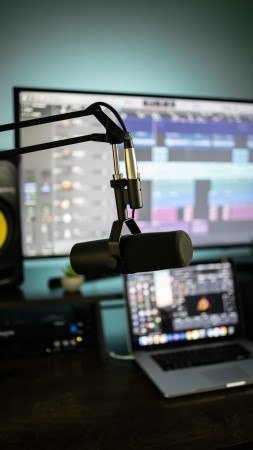
Why is the SM7B so Popular?
The Shure SM7B is so popular due to the 7 reasons we’ll discuss below. In a nutshell, it has an incredibly wide dynamic range, sensitive frequency response, is flexible and versatile, it offers the highest sonic performance of any mic in its class, is almost indestructible, it features a range of onboard controls to tackle different environments without being complicated, and is way under £500 - making it attainable for anyone willing to extend their budget.
Put simply, the SM7B provides unrivalled vocal and instrumental recording clarity and versatility at a price point that anyone can get to.
But let’s go a little deeper on the reasons why you need the Shure SM7B and why it's worth it.
7 Reasons You need The Shure SM7B Microphone
Here are 7 reasons why you need the Shure SM7B in your studio or home recording set up. In this list we’ll look at the following features:
- Dynamic type
- 3 Frequency types
- Off-axis rejection
- Flexibility/Versatility
- Construction/Design
- Built-in pop filter (and included windscreen)
- Price
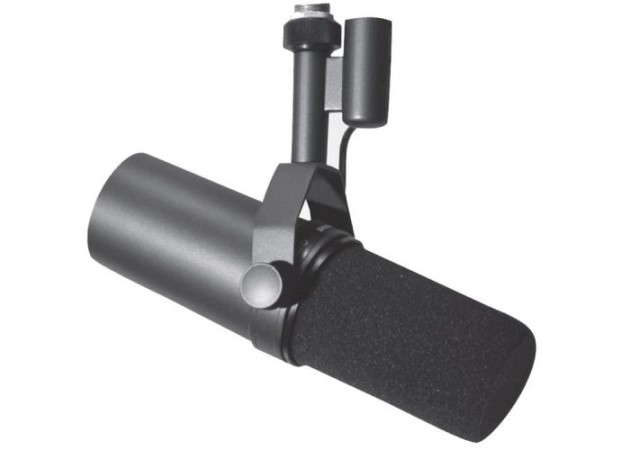
The Shure SM7B is a Dynamic Mic
One of the key benefits of the Shure SM7B is the fact that it’s a dynamic microphone. Often studio vocal microphones are condenser mics which may offer too much sensitivity depending on the sound source. If you’re a heavy breather or are not trained to deliver vocals correctly, and you want to create a clean vocal sound, this can sometimes be a problem as condensers pick up almost EVERY tiny inflection. They can also distort if you’re a loud vocalist and you’re not able to manipulate the gain control on your interface.
As the Shure SM7B is a dynamic mic, this means it is VERY forgiving in a studio environment as the lower sensitivity, when compared to a condenser mic, means that it will pick up far fewer bumps and knocks sonically and can handle a huge amount of sound pressure before it distorts. The max SPL of 180dB which is louder than a jet engine ensures that you can record the loudest, heaviest vocals or the screamiest vocalist in the world before you go anywhere near distortion.
If you want to increase the sensitivity and don’t have the ability to increase gain via an audio interface you may want to add a preamp such as the sE Electronics DM1 Dynamite in Line Mic Pre-Amp. Although this is not required.
Yes, the Shure SM7B is less sensitive than a condenser, but only in the way that it doesn’t pick up the unwanted sound sources or mechanical noise that some condensers might. It’s still very sensitive to the sonic quality of the sound source. This means it will pick up the subtle nuances of your voice without unwanted breath or mouthy sounds. It’s everything you need and nothing you don’t.
It’s still perfect for voiceovers and speech recording – hence the fact it’s widely regarded as one of the best broadcast microphones of all time.
3 Different Frequency Responses
The 50 to 20,000 Hz frequency response makes the Shure SM7B perfect for all manner of studio recording including vocals whether for voiceovers, podcasting, broadcasting or singing, as well as acoustic guitars, electric guitars, drums – anything where you want a clean, accurate representation!
This frequency response ensures you already have full-fat low end to keep the bass intact and the higher frequency response ensures the detail is captured.
However, the SM7B has a few tricks up its sleeve for those in need of more sonic control.
You actually have 3 different frequency response settings built-in including Flat Response, Bass Rolloff and Presence Boost.
Why is this important?
The Flat Setting
The Flat Frequency Response provides a natural, smooth and transparent recording quality which is great for field recording or vocal capture. However, if you want to record a jumbo dreadnought, bass-heavy acoustic guitar or a vocalist with a particularly low voice, you may find that the proximity effect and unwanted “boominess’ start to creep in. Hence the bass Roll off feature!
Bass Rolloff
The bass rollof feature switch allows you to reduce the amount of bass captured from the ShureSM7B. It’s like a built-in high pass filter that attenuates the lower frequencies and reduces the low-hum from electronic frequencies, the boominess of a guitar or lower voice or the unwanted sound from the proximity effect.
Presence Boost
If you want a little more high-end detail or treble from your recording, the Presence boost on the Shure SM7B is perfect for accentuating and bringing out the mids and treble of your sound source. If you record acoustic guitars or want to bring more presence to the recording of vocals, this switch is perfect. We suggest recording one acoustic without the setting engaged and overdubbing with another in the studio with the presence boost activated. Likewise for vocals as it really adds a subtle, yet noticeable dimension to your recording.
You have total control over your sound without the need for a recording engineer!
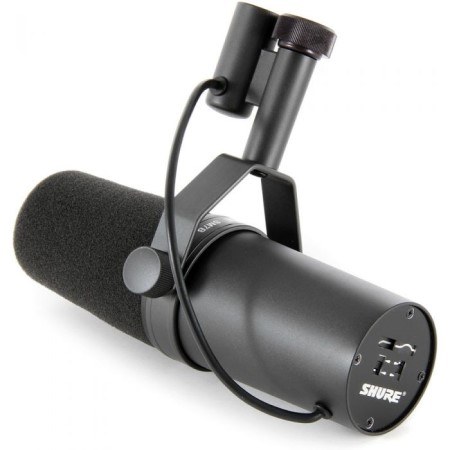
Off Axis Rejection
One of the main reasons the Shure SM7B is considered one of the best broadcast and podcast microphones, and a key reason you need it, is the superior off-axis rejection.
The Shure SM7B is a dynamic microphone with a cardioid polar pattern which means it rejects all the surround behind the mic almost completely. This is perfect for broadcasters and podcasters as the microphone only captures what is in front of the microphone, rejecting the background noise for a clearer recording.
This also means you can place the mic almost anywhere in a room without worrying about acoustic treatment and be sure you’re going to get a great quality recording as the mic won’t pick up that ticking clock behind it or the wind coming through the window of your studio.
The dynamic and cardioid polar pattern combination really helps to minimise distortion when recording louder sound sources and won’t clip as much as a condenser microphone.
Flexibility/Versatility
Yes, the Shure SM7B is predominantly a vocal, podcast and broadcast microphone. But it’s still very versatile. The combination of the dynamic construction and switchable frequency responses already highlights that. However, it’s the Max SPL of 180 dB that really shines.
A jet engine is around the 112 dB level, the Shure SM7B is capable of handling well over that. This means that your loudest drummer, singer or brass player is catered for.
Again, if you’re recording lower volume sound sources like speech, then we recommend getting a preamp, but if you’re going to be recording electric guitars, drums, brass or even acoustic pianos – you’re fine as the mic can more than handle higher sound pressure level.
Construction/Design
The SM7B diaphragm differs from a lot of microphones out there as it has been optimized for increased low-end response – this is why it’s so long!
The larger housing of the SM7B is an intentional feature. This design effectively captures more volume behind the cartridge which produces a more low-end response. This is why your vocals sound full and thick when compared to other dynamic microphones.
The construction of the mic is also a major benefit as the internal shock mount of the SM7B effectively eradicates microphone mechanical vibrations. This means that you get less noise from a knock on a table or when you touch the microphone accidentally, thanks to the Internal “air suspension” shock isolation system.
The design of the microphone also reduces mechanical hum from computers and electrical appliances around you which means you get a pure signal unaffected by computers, audio interfaces or smart devices.
It’s just you and the sound source!
Built-In Pop Filter and Included Windscreen
If you’re looking at upping your vocal recording and creating crisp, clear podcasts then you’ll need a pop shield to reduce plosives and a windshield to reduce breath. Fortunately, the Shure SM7B comes with both.
The capsule is housed in a custom-made pop shield to protect it, but also ensure the plosive noises are heavily reduced. The included windscreens in the box ensure you’re ready for all vocal applications.
This is just one of the key reasons you need a Shure SM7B – it basically offers recording studio quality straight out of the box.
The Price
Once again, the Shure SM7B is a professional, broadcast level microphone used by some of the world’s biggest names in music and podcasting.
It’s also very affordable if you’re willing to save up a little extra.
The Shure SM7B is entirely attainable. It could be classed as one of the best intermediate microphones or one of the best expensive microphones depending on your budget and what you think is expensive. Either way, the Shure SM7B provides exceptional clarity, near-indestructible construction and a host of useful features that bring out the best in your sound source.
It's an essential piece of kit and easily worthy of PMT Legend status.
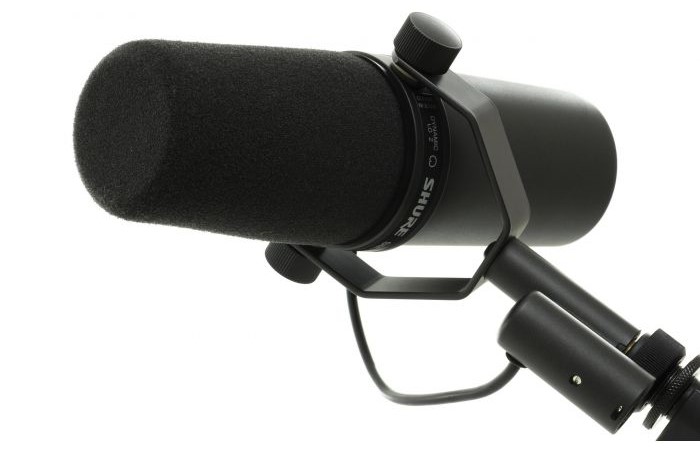
Is The Shure SM7B Worth It?
If you want professional, world-class broadcast quality sound for under £500, then the Shure SM7B is definitely worth it. The built-in sound scaping features allow you to make subtle, yet important changes to your sound without the need for professional-level skill and the built-in pop and windshield means you don’t have to buy anything else to improve vocal delivery.
As Shure say themselves: it’s the mic you’ve already heard – almost everyone in the world of podcasting to sound production has the Shure SM7B in their studio or set up because it’s just so reliable, provides exceptional sonic clarity and will last a lifetime. It’s essentially plug and play studio-quality sound for under £500.
So yes, if you value high-quality sound it’s worth it.
Now for Some FAQ’s!
Shure SM7B FAQs
Does the Shure SM7B come with a stand?
No, it does not. It does provide easy installation to a boom stand thanks to yoke mounting with an internal stand nut as well as a handy bracket that swivels so you can adjust the positioning of the microphone.
How can I make my SM7B sound better?
You may need some extra gain to make your Shure SM7B sounds better. The Shure SM7B requires around 60dB of gain to record vocals and speech at highest quality. Although you can use your interface to drive the gain, you may need an external preamp such as the sE Electronics DM1 Dynamite in Line Mic Pre-Amp to achieve this.
Adding more gain is often the answer to making your Shure SM7B sound “better”.
Why is the SM7B so expensive?
High-quality construction, included pop filter and windshield, onboard switchable frequency response, 180dB max SPL, air suspension shock isolation, advanced electromagnetic shielding and detailed audio profile. The list goes on, but a lot of work has gone into making this the most user-friendly microphone that you will never have to upgrade. Crystal clear clarity, hardwearing and reliability – there’s not a lot to complain about when you get to the price tag considering the quality you get.
Is the SM7B good for vocals?
Yes, the switchable frequency response caters to all manner of vocals, the max SPL of 180dB ensures you can handle shouting/screaming and the built-in pop shield and windscreen keep your single breath and plosive free.
Is Shure SM7B a condenser mic?
No - the Shure SM7B is a dynamic studio microphone with a cardioid polar pattern.
Who uses the Shure SM7B?
What kind of microphone does The Weeknd use? What kind of microphone does Joe Rogan use? What kind of microphone does Ariana Grande use?
They all use the Shure SM7B for vocals and Joe uses them on his podcast, the Joe Rogan Experience. So, it’s safe to say you’re in good hands.
Does the Shure SM7B need Phantom Power?
No. it’s a dynamic microphone so does not need phantom power.
Does the Shure SM7B need a preamp?
Yes and no - the Shure SM7B benefits from the use of a preamp and needs around 60dB of gain to capture lower-volume sound sources. However, this is not essential. If you have an audio interface that you can use to crank the gain, then you’re covered. If you’re recording electric guitars, drums or even louder acoustic guitars you won’t need one.
Does the Shure SM7B work on acoustic guitar?
Absolutely. The Shure SM7B has a frequency response catered to acoustic guitars and the built-in frequency switch allows you to record all manner of acoustic guitars. Use the Flat setting for mini acoustic, the Bass roll-off for jumbo acoustic and the Presence boost for lead acoustic guitars and fingerpicking.
Was the SM7B used to record Thriller?
Well, technically the SM7, introduced in 1973 was used to record Michael Jackson’s Thriller, but the microphone had a slight reconfiguration in 2001 and was relabelled as the SM7B… but that’s for another article.
In short, you’re getting the same microphone that Michael Jackson used to record his vocals for Thriller – so you’re in good company!
Final Thoughts on the SM7B
At the end of the day, the Shure SM7B is easily one of the world's greatest microphones at a price point that you can’t argue with. It is quite simply peerless and relied upon by thousands of broadcasters, podcasters, studio owners and more.
It is in line with the Shure SM57 and SM58 in terms of industry-standard status. You won’t ever regret buying one or ever have to upgrade, only add to your collection.
Happy recordings!

